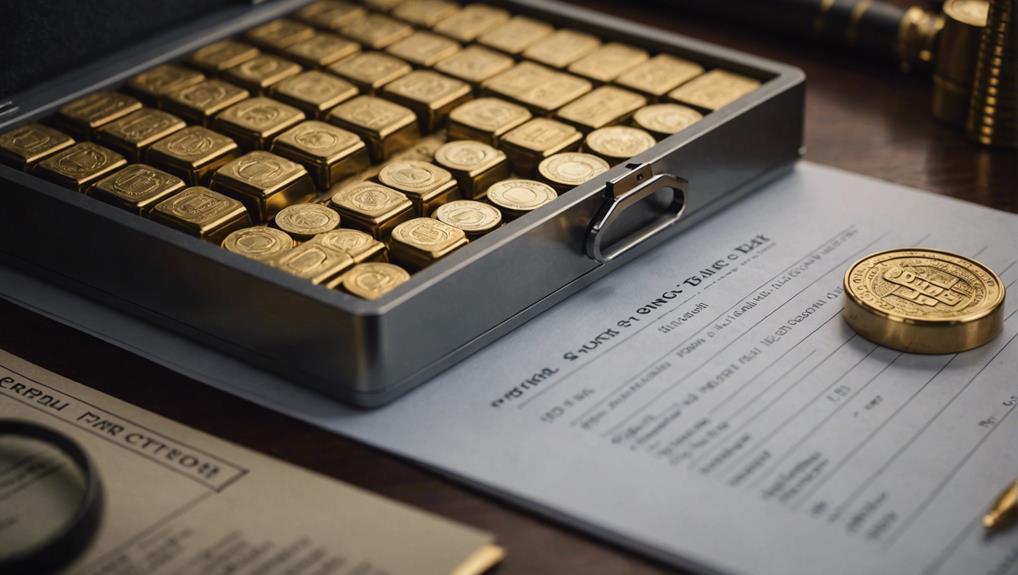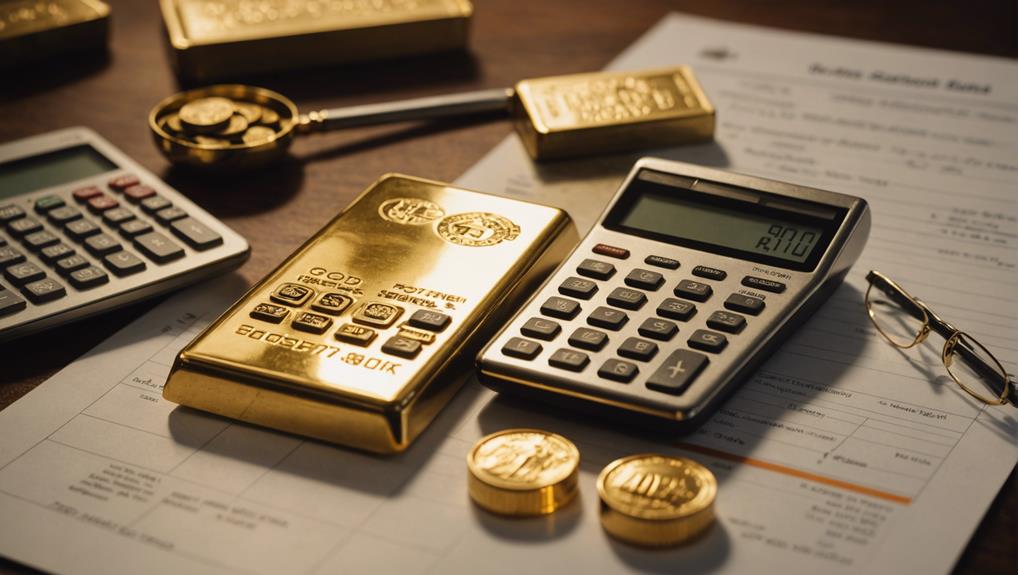Investing in Gold IRAs requires a comprehensive understanding of both their benefits and drawbacks. You must evaluate market volatility, storage, and insurance costs, as well as liquidity challenges.
Additionally, it’s crucial to know the eligibility requirements and which metals are accepted. Familiarity with the setup process, custodianship details, and various fees involved is also essential.
Are you ready to navigate these complexities to make an informed investment? Let’s explore each of these critical factors in greater detail.
My Quick Highlights
What You Should Know Before Investing in Gold IRAs
- Understand the tax advantages and implications, including potential tax-free qualified withdrawals.
- Be aware of the high fees, which can include setup, maintenance, storage, and termination costs.
- Know that gold IRAs are subject to market volatility, which can impact the value unpredictably.
- Recognize the challenges and expenses related to storing and insuring physical gold.
- Ensure compliance with IRS regulations regarding eligibility and approved metals
Benefits of Gold IRAs

Investing in Gold IRAs offers notable tax advantages, such as tax-free qualified withdrawals with Roth IRAs upon retirement. Integrating gold IRAs into your retirement portfolio provides various tax benefits while diversifying your investments.
Gold acts as an effective hedge against inflation, safeguarding your assets from the detrimental effects of rising prices. The substantial purchases of gold by global central banks demonstrate its enduring value as a store of wealth.
Gold IRAs are subject to specific IRS regulations, ensuring that your physical gold meets established purity and storage standards. Diversifying with gold IRAs not only enhances your retirement savings but also provides stability during economic uncertainties, making it a prudent investment choice.
Risks and Drawbacks
When contemplating gold IRAs, it’s important to understand the risks and drawbacks involved. Market volatility can lead to significant fluctuations in gold’s value, impacting your investment.
Moreover, you’ll face costs for storing and insuring physical gold, and selling it can be more complicated compared to traditional investments, potentially limiting your access to funds when needed.
Market Volatility Concerns
Gold IRAs are susceptible to market volatility, leading to unpredictable price fluctuations that can affect your investment’s value. Gold pricing is influenced by economic uncertainty, geopolitical risk, and investor sentiment. Despite being considered a safe haven asset, gold can exhibit significant market volatility.
Consider these factors:
| Factor | Impact on Gold IRAs |
|---|---|
| Economic Uncertainty | Can drive prices up or down |
| Geopolitical Risk | Often increases demand for gold |
| Investor Sentiment | Causes fluctuations in gold pricing |
Understanding these factors helps prepare for potential risks and drawbacks. Gold’s value may not always align with other asset classes, so assess your risk tolerance before investing.
Storage and Insurance Costs
Market volatility introduces one set of challenges, while the costs and risks associated with storing and insuring physical gold in a Gold IRA present another.
Storage fees typically range from 0.5% to 1% of the gold’s value annually. Insurance costs for approved storage facilities further add to your expenses. Secure storage options are essential to mitigate risks like theft, damage, or improper handling.
Storing gold at home is risky and not recommended. When considering a Gold IRA, it’s crucial to account for these storage and insurance costs to assess overall feasibility. Understanding these expenses is necessary for making an informed investment decision.
Liquidity and Exit Challenges
Managing the liquidity and exit challenges of a Gold IRA demands careful assessment of associated costs and prevailing market conditions. Liquidity issues occur because selling physical metals requires time and effort.
Exiting a Gold IRA often involves additional expenses, such as selling fees and storage fees. Market conditions play a crucial role in the ease of selling; during a downturn, gold might sell for less than its purchase price. Investing in Gold IRAs can be both costly and complex.
Understanding these challenges allows for more informed decisions about whether a Gold IRA fits your investment strategy.
Eligibility and Acceptable Metals

To invest in a Gold IRA, you need to meet specific age and income requirements set by the IRS.
It’s important to choose IRS-approved precious metals like gold, silver, platinum, and palladium, which must meet certain purity and quality standards.
Not all metals qualify, therefore ensuring compliance with these regulations is vital for a smooth investment process.
Age and Income Requirements
To invest in a Gold IRA, you must be at least 18 years old and have earned income, making it crucial to verify these criteria before proceeding.
Gold IRAs, a type of individual retirement account (IRA), adhere to IRS regulations, including specific age and income requirements. Contributing to a Gold IRA requires earned income, ensuring active workforce participation. No minimum income level is mandated, allowing accessibility for a broad range of investors.
Confirming your eligibility is essential before investing in Gold IRAs. Meeting these requirements ensures compliance with IRS rules, paving the way for a smoother and more secure financial future.
IRS-Approved Precious Metals
Curious about which precious metals are eligible for inclusion in a Gold IRA? The IRS permits investments in specific precious metals such as gold, silver, platinum, and palladium. For gold, eligible products include American Eagle, Canadian Maple Leaf, and Australian Kangaroo coins. Note that collectible or numismatic coins aren’t permitted; only bullion coins and bars qualify.
Silver, platinum, and palladium must also meet stringent IRS guidelines to be included. These regulations ensure the metals in your IRA maintain high standards and comply with federal requirements. By investing in IRS-approved precious metals, you can diversify your portfolio while adhering to the legal framework established by the IRS.
Purity and Quality Standards
When considering a Gold IRA, it’s crucial that the metals meet specific purity and quality standards set by the IRS. For gold bars, a minimum fineness of 0.995 is required to ensure high purity standards.
Acceptable metals for precious metals IRAs include gold, silver, platinum, and palladium, all of which must adhere to IRS guidelines for eligibility.
Eligible gold coins for a Gold IRA may include American Eagle, Australian Kangaroo, and Canadian Maple Leaf coins. These metals must be stored in IRS-approved depositories to ensure compliance with purity and quality standards.
All precious metals in a Gold IRA undergo verification processes to confirm their authenticity and adherence to IRS regulations.
Setting Up a Gold IRA
To set up a Gold IRA, you need to find a custodian who specializes in handling IRS-approved precious metals. This custodian will coordinate with a metals dealer and a depository to establish your account.
Initially, fund the account with the custodian before purchasing any metal. The risks of investing in Gold IRAs will then facilitate the purchase of specific bullion metals for storage in an IRS-approved facility.
It’s crucial to avoid prohibited transactions, such as violating storage or purity standards, to keep your IRA compliant.
- Choose a reputable custodian: Ensure they’ve experience with Gold IRAs.
- Collaborate with trusted professionals: Both the metals dealer and depository should be reliable.
- Understand IRS rules: Adhering to regulations prevents costly mistakes.
Custodianship and Storage

A custodian plays a crucial role in managing your Gold IRA and ensuring adherence to IRS regulations. They handle the purchasing and storage of physical metals such as gold and other approved precious metals. These assets can’t be kept at home; they must be stored in IRS-approved, secure facilities.
This custodianship ensures your investment remains compliant with all IRS regulations. The custodian oversees the acquisition of specific bullion metals and ensures they’re correctly stored. Violating storage or purity standards can result in prohibited transactions and penalties.
Selecting the right custodian is essential for the safety and legality of your Gold IRA, making it important to thoroughly research and choose a reputable one.
Costs and Fees
Understanding the costs and fees associated with Gold IRAs is crucial for making an informed investment decision. These accounts come with setup, maintenance, and storage fees. Yearly gold storage fees typically range from 0.5% to 1% of the total metal value.
Additionally, custodians charge for account administration, recordkeeping, and extra services like wire transfers. Due to the purchase and storage of physical metal, Gold IRAs tend to have higher fees compared to traditional IRAs.
- Setup Fees: Initial costs to establish the IRA account.
- Maintenance Fees: Ongoing charges for account administration.
- Termination Fees: Costs incurred if you close the account early.
Being aware of these fees helps you evaluate the pros and cons of gold IRAs, understand investment fees, and consider their tax implications, aiding in retirement account diversification.
Conclusion
Investing in a Gold IRA offers both benefits and challenges. Understanding market risks, storage costs, and liquidity issues is essential. Ensure you meet eligibility requirements and know the accepted metals.
Setting up and maintaining a Gold IRA involves selecting a reliable custodian and being aware of fees. By carefully evaluating these factors, you’ll be better prepared to decide if investing in gold aligns with your retirement goals and financial strategy.
The Gold Information Network
11900 Biscayne Blvd, Ste 127B, Miami, FL 33181
(305) 449-9094
https://goldinfo.net







